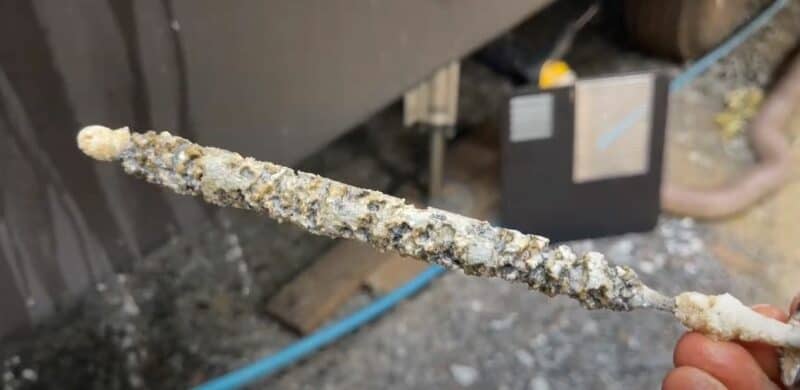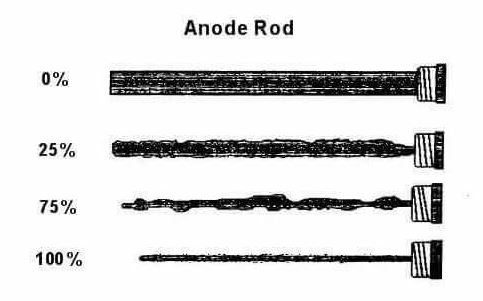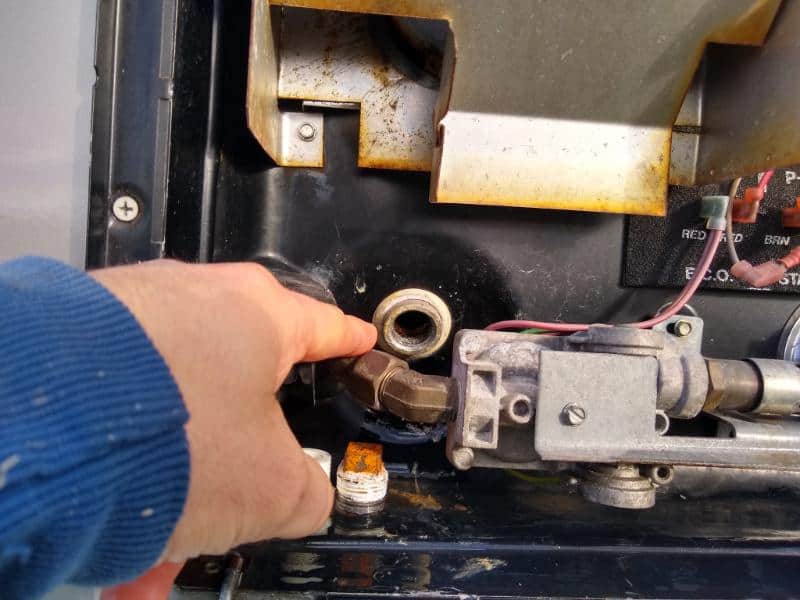If this is the first time you’ve heard about an anode rod, chances are …. you’re in trouble. Many RV conventional water heaters require an anode rod to protect the metal tank. Water carries minerals that will eat away common metals; the anode rod lays down its life for the sake of its friends, and no greater love hath man than this.
Here’s the short version of the answer, even though it’s not quite accurate:
- Steel tanks, used by Suburban water heaters, usually require an anode rod, which should be replaced every 1-2 years or as needed.
- Aluminum tanks, used by Dometic/Atwood water heaters, usually do NOT require an anode rod.
Not sure which one you have? You can open the exterior access door of your water heater and take a peak at the data label. The manufacturer and model number of your water heater will be listed therein.

There are only two major manufacturers of conventional RV water heaters, Dometic (who bought out Atwood) and Suburban (owned by Airxcel), so it’s a pretty short list!
***
Now that I’ve given you the short answer, let me tell why it’s wrong –
– because some people (or RV blogs) will tell you that steel tanks require an anode rod to protect against rust, and because aluminum doesn’t rust, it doesn’t need an anode rod. That is NOT true.
Actually, both tanks require cathodic protection!! But Dometic has cleverly integrated the protection into the tank lining itself; Suburban has chosen to rely on a separate, replaceable anode rod.
What Is an RV Water Heater Anode Rod?
An anode rod is a replaceable metal rod designed to protect the tank of your RV water heater. They also protect sensitive metal instruments inside your tank, such as temperature cut-off switches.
All sacrificial anodes work on the principle that their metals are more responsive to corrosive elements than the tank itself is. There is another type of anode, called a powered anode, that uses electrical current pulses for cathodic protection, but they aren’t used in RVs.

Anode rods are necessary in RVs because the quality of water at many campgrounds is less than the municipal water you’re used to. It’s often well water, full of elements like iron and calcium. It’ll do significant damage to your RV’s water system.
Here, in quick succession, are some common FAQs and answers about RV water heater anode rods.
What Is an RV Anode Rod Made From?
There are two types of water heater anode rods:
- Magnesium: Best for soft water and the widest range of protection. It’s the most common choice for RV water heaters.
- Aluminum/zinc: Best for hard water and water rich in sulfates, which can cause a rotten egg smell.
All standard RV anode rods are 0.75 inches in diameter and 9.25 inches long.
Does My Water Heater Need an Anode Rod?
If made by Dometic or Atwood, then no. If made by Suburban, then yes.
Does an Instant Water Heater Need An Anode Rod?
No, tankless/on-demand/instant water heaters don’t use anode rods (Bosch is an exception). They do actually have a very small water reservoir inside of them, but the reservoir is made of copper and doesn’t require cathodic protection. Truma uses de-calcification tablets instead of an anode rod to help clean out the mechanical guts.
How Long Does an Anode Rod Last?
The longevity of an RV anode rod depends on the quality of the water, the anode rod material, and how often you use your hot water. Generally, an anode rod should last at least a year, but full-timers may need to check it every 6 months.
If your anode rode is completely deteriorating within six months, you should try switching to the other type (aluminum/zinc or magnesium) for a longer lifespan. You can also make an anode rod last longer by not storing your RV for long periods with water in the hot water tank.
>>> READ MORE: Can I Leave Water Sitting in My Freshwater Tank?
When Should an Anode Rod Be Replaced?
Here’s an infographic showing the lifespan of an anode rod (see below). The usual recommendation is to replace the rod when it has used up 75% of its life. Don’t wait until it’s completely gone!

If you’ve delayed replacing your anode rod, you’ll also likely need to drain, flush, descale, and sanitize your water tank. I’ll save those instructions for another post.
How to Replace a Water Heater Anode Rod?
Anode rods are usually screwed into a ¾” NPT tapped fitting at the bottom of a tank. The most common socket size for the hex head is 1-1/16”. You can access the hex head by opening the exterior access door and peering beneath the gas burner assembly (see my picture in the next section).
If you check and/or replace your anode rod every year, then removal and replacement is not difficult. When installing a new anode rod, coat the threads with white Teflon tape and food-grade pipe dope to stop water leaks and prevent galling.
For more information, you can check out this video from the National RV Training Academy (one of my alma maters):
How to Replace An Anode Rod That’s Stuck?
However, if you haven’t replaced your anode rod in a while, it might be rusted in place. You’ll have to use penetrating oil, a blow torch, breaker bar, or another one of Grandpa’s tricks to break it loose. You’ll also likely need to clean and re-tap the threads with a thread chaser. Use anti-seize when installing the new anode rod!
What Will Happen If I Don’t Replace My Anode Rod?
You’ll kill your water heater, that’s what! The walls of the tank willl corrode and eventually spring a leak. At this point, it’s usually recommended to replace the entire water heater, which will cost $400-$600 plus installation.
Anode rods don’t just protect your water heater; they also help clean up the water! If you detect a sulfurous odor like rotten eggs, that’s a symptom of a dying anode rod. If you don’t replace your anode rod, you might also get more limescale in your plumbing fixtures. Not good.
Why Don’t They Make Stainless Steel Tanks Instead?
That’s a great question! I’m not sure. I would assume because of the extra cost? I know stainless steel works well for some residential and commercial water heaters …
Should I Install An Anode Rod In a Dometic Steel Water Heater?
You may have heard it recommended to install an anode rod in a Dometic glass-lined tank even though it doesn’t have one from the factory. In fact, you can buy aftermarket anode rods that fit in the spot usually reserved for the white plastic drain plug.

DO NOT DO THIS!! It voids the factory warranty. I’ve heard Dometic technicians recommend against installing aftermarket anode rods because the steel threads of the anode rod will chemically react with the aluminum tank fitting (plus, aluminum is infamous for galling anyway). It can literally freeze itself into place, and now you can’t drain your water heater!
If your water smells bad, you should start by thoroughly cleaning and sanitizing your fresh water tank, water heater, and plumbing system. If that doesn’t do the trick, you should look into RV water filtration/purification systems (there are lots to choose from). Don’t put a Band-Aid on the issue with a bootleg anode rod.
The Science Behind Anode Rod Corrosion
NERD ALERT: You are welcome to skip this section if you don’t like the science stuff.
The Basics of Galvanic Corrosion and Cathodic Protection
All metals can corrode under the right conditions, and most react very quickly with the oxygen in air and water. Some metals, like pure iron, corrode very quickly. We call this corrosion “rust,” and we hate it because it flakes off so easily. Some metals, like stainless steel, actually form a protective surface oxide layer that defends against future corrosion. We call one process “corrosion” and one “oxidation” because one deteriorates and the other protects; same reason we call one plant a “flower” and the other a “weed.”
Secondly, most metals are subject to galvanic corrosion. Galvanic corrosion occurs whenever two dissimilar metals are in electrical contact with other, which usually means immersed in some kind of electrolyte, like a water-salt (aqueous) solution. One metal becomes the cathode, and becomes the anode, and you’ve basically invented an electrochemical battery. A small electrical current flows from one to the other. The anodic (less noble) metal will rapidly corrode. The rate of corrosion is based on a lot of factors, such as the ratio of exposed surface area, operating conditions, the galvanic index difference of the two metals, etc.
Dometic Water Heaters Have a Built-In Anode, Actually!
As I said earlier, both steel and aluminum tanks do require some kind of cathodic protection. But Dometic has integrated the protection within the tank itself. Here’s what they say:
“The Atwood water heater tank is constructed of a core of high strength aluminum. The interior of the tank consists of a 15% thickness of type 7072 aluminum (pure aluminum and zinc) that is fused to the core during the rolling process. This material protects the tank from the effects of heavy metals and salts found in waters throughout the country. It is anodic to these heavy metals and acts much like an anode in a steel glass lined tank except it will last much longer. There is also no need to replace an anode on a yearly basis.”
-ATWOOD (DOMETIC)
There’s a tradeoff, of course. It means the tank has a limited lifespan. But considering that I’ve worked on 32-year-old Dometic water heaters, I wouldn’t fret about that too much.
Wait … Why Do Glass-Lined Suburban Tanks Need an Anode Rod?
If you’re a particularly observant person, you may have noticed earlier in this article that a Suburban tank uses a glass-lined*steel tank. That begs the question: If glass porcelain doesn’t corrode, why use an anode rod at all?
That’s because we don’t live in a perfect world. Over time, the glass lining develops microcracks and pinholes. This is because of thermal shock, vibration, and general wear n’ tear. This exposes a part of the steel tank to the water within; an anode rod is the next line of defense.
*You may hear these tanks referred to as glass-lined, porcelain-lined, or enamel-lined. Technically, all these terms are accurate.
Leave a Reply